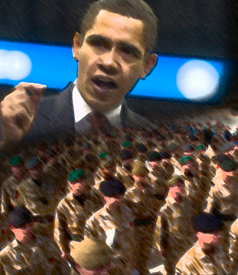Disputes are raging within the Obama administration over how to continue the US war effort in Afghanistan. A new leak tells us that Washington’s ambassador in Kabul, former four-star Gen. Karl Eikenberry, has cautioned against adding more troops while President Hamid Karzai keeps disappointing American policymakers. This is the extent of the current debate within the warfare state.
During a top-level meeting Wednesday afternoon in the White House, The Washington Post reports, President Obama “was given a series of options laid out by military planners with differing numbers of new US deployments, ranging from 10,000 to 40,000 troops. None of the scenarios calls for scaling back the US presence in Afghanistan or delaying the dispatch of additional troops.”
No doubt, there are real tactical differences between Eikenberry and the US/NATO commander in Afghanistan, Stanley McChrystal, the ultra-spun, brainy Spartan who wants to boost the current US troop level of 68,000 to well over 100,000 in the war-afflicted country. But those policy disputes exist well within the context of a permanent war psychology.
What’s desperately needed is a clear breakaway from that psychology, which routinely offers “kinder, gentler” forms of endless and horrific war. But predictably, in the days and weeks ahead, some progressives – from the grassroots to Capitol Hill – will gravitate toward Eikenberry’s stance.
Fine-tuning the US war in Afghanistan is no substitute for acknowledging – with words and with policy – that there will be no military solution. Adjusting the dose and mix of military intervention is a prescription to do more harm on a massive scale.
A recent spate of media stories has focused on soldiers, veterans and family members struggling with PTSD and other heartbreaking consequences of deployments to Iraq and Afghanistan. One of the key messages is that the government must do a better job of caring for battle-scarred veterans.
To the great extent that such stories don’t question continuation of the warfare, they’re part of the stampede. As long as the only options put forward have to do with finding better ways to cope with ongoing war, the men and women in the military are framed as people who are most admirable as participants in their own suffering (and, implicitly, as people who are willing to inflict suffering on others).
The suffering of Afghan people, meanwhile, gets short shrift in the USA’s media and political discourse. While we hear – though not enough – about traumas that continue to plague Americans many months or years after being in war zones, we hear almost nothing about the traumas that the US military visits upon people living in the occupied country.
After 30 years of war, Afghans do not need more ingenious war efforts by the latest batch of best and brightest in Washington.
Thundering along Pennsylvania Avenue, the stampede for war is hard to resist. It’s a stampede that few members of Congress have been willing to directly challenge. So, the “serious” policy arguments, from the White House to Capitol Hill, have remained bullish on war – and eager to find better ways to wage it.
The November 12 edition of the Post reported that Ambassador Eikenberry “has expressed frustration with the relative paucity of funds set aside for spending on development and reconstruction this year in Afghanistan, a country wrecked by three decades of war.” The newspaper added, “Earlier this summer, he asked for $2.5 billion in nonmilitary spending for 2010, a 60 percent increase over what Obama had requested from Congress, but the request has languished even as the administration has debated spending billions of dollars on new troops.”
The Obama administration is spending upwards of 90 percent of all US funds in Afghanistan on military operations – and what Eikenberry is seeking would add up to mere drops in the bucket compared to what Afghanistan really needs for “development and reconstruction.” Nor is the US government in any moral or logistical position to effectively supply such aid.
Right now, the paltry aid from Washington is largely disbursed in Afghanistan as an adjunct to the Pentagon’s military operations – and it is widely recognized as such. That’s why the resulting projects are so often blown up or burned down by insurgents.
In war-ravaged Afghanistan, one of the poorest countries in the world, effective aid is possible. While woefully underfunded, the National Solidarity Program and the Aga Khan Foundation are prime examples of successes – if the goals are genuine humanitarian aid and development rather than providing “hearts and minds” photo-ops and leverage for the occupiers’ military campaigns.
The current dispute over how to continue the war in Afghanistan should not be mistaken for an argument over basic assumptions. And what’s wrong with US intervention in Afghanistan is fundamental.
Join us in defending the truth before it’s too late
The future of independent journalism is uncertain, and the consequences of losing it are too grave to ignore. To ensure Truthout remains safe, strong, and free, we need to raise $44,000 in the next 6 days. Every dollar raised goes directly toward the costs of producing news you can trust.
Please give what you can — because by supporting us with a tax-deductible donation, you’re not just preserving a source of news, you’re helping to safeguard what’s left of our democracy.
